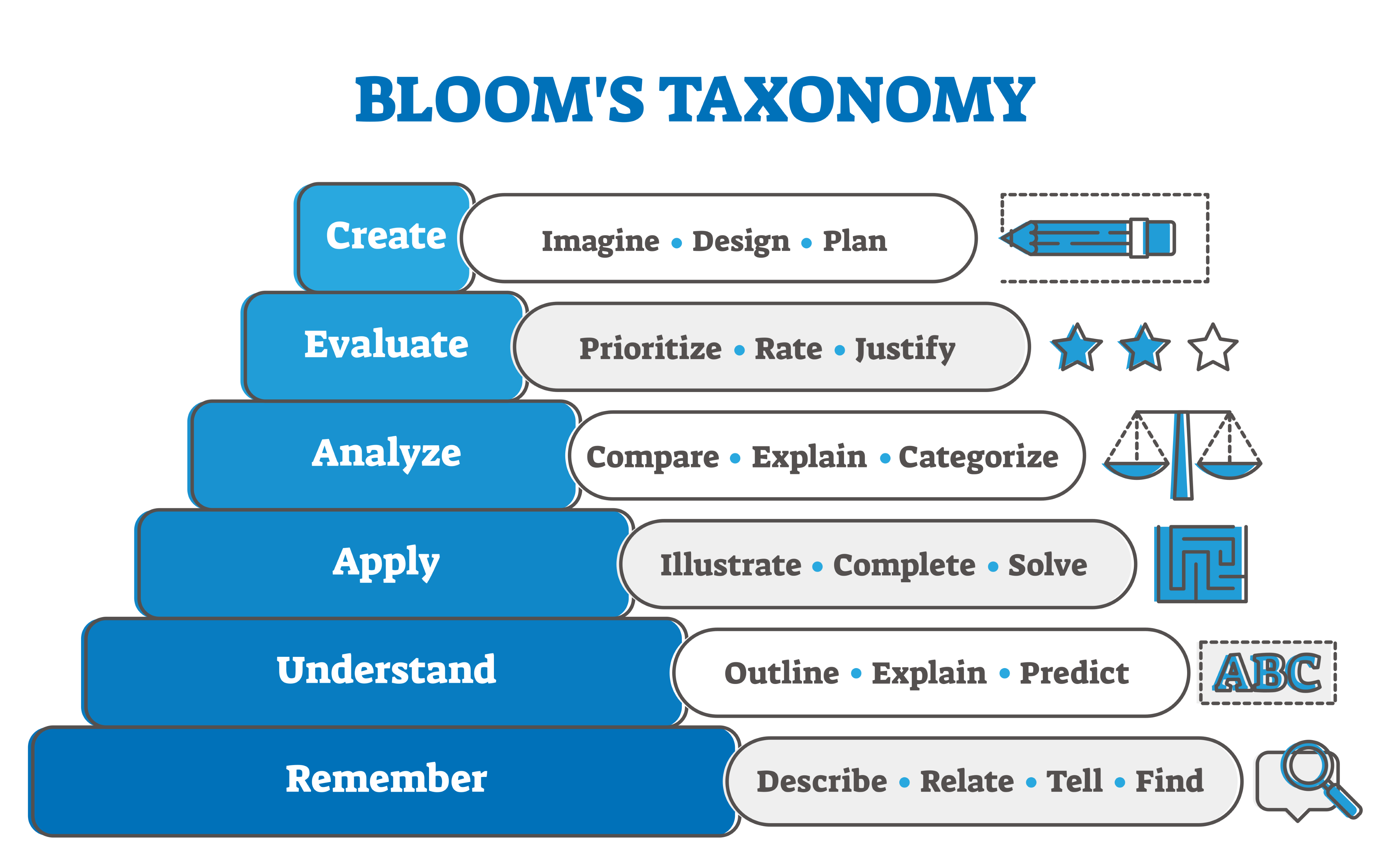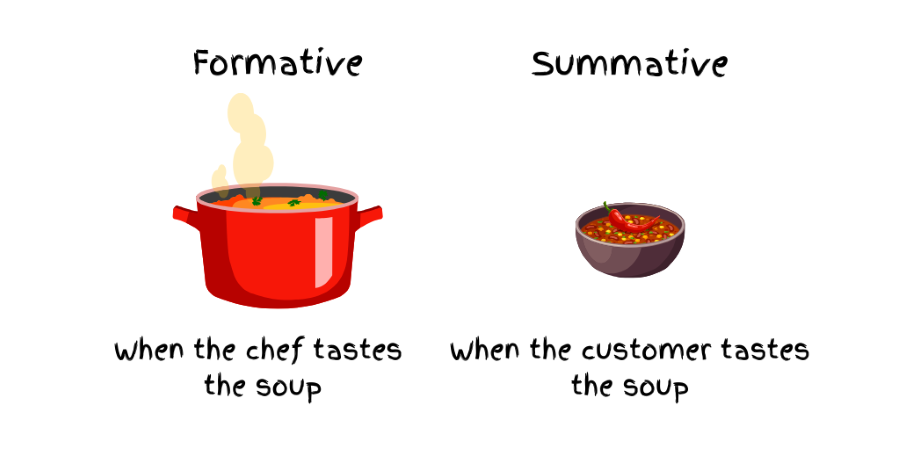Designing Assessments
What do you want students to do?
In the 1950s, educational psychologist Benjamin Bloom and his colleagues proposed
a system of classifying educational objectives. This ubiquitous system, known as Bloom’s
Taxonomy, is tremendously helpful as you think about what you want your students to
be able to do in your course and how (and where) you might deepen their learning.
Note how the six levels of objectives build upon one another, involving deeper cognition
at each level:
⦁ Remember, or the ability to recognize and recall things
⦁ Understand, or the ability to grasp and interpret things
⦁ Apply, or the ability to employ facts, concepts, or ideas to solve new problems
⦁ Analyze, or the ability to break down information into component parts
⦁ Evaluate, or the ability to judge the value of information or ideas
⦁ Create, or the ability to combine smaller elements of things to create a larger thing
Because the sixth level, “create,” is considered the most complex and likely involves
a summative assignment, most illustrations of Bloom’s Taxonomy begin with this level
of cognition on top with the shallowest level, “remember,” on the bottom, like this:

To illustrate the differences in a fun way, imagine if students were studying the story of “Snow White and the Seven Dwarves,” you might ask them to
⦁ Remember—List the names of the seven dwarves and describe their key characteristics.
⦁ Understand—Explain the moral lessons of the story.
⦁ Apply—Use a feminist lens to evaluate the portrayal of female characters in the story.
⦁ Analyze— Examine the use of symbolism in the story, such as the poisoned apple and the mirror.
⦁ Evaluate—Critique the actions of the Queen and discuss alternative actions she could have
taken.
⦁ Create—Design a modern adaptation of the story, considering contemporary issues and themes.
What type of assignment should you choose?
To measure students’ success in achieving course goals and outcomes, you will want to provide a variety of learning assignments. Let’s explore a few approaches.
Formative vs. Summative Assessments
Summative assessments (e.g., exams or term papers) are high stakes, making up a significant part of the course grade, and often require students to demonstrate a range of skills and knowledge. They require a considerable investment of time, both from students and from instructors, and are consequently completed outside of class. In contrast, formative assessments are designed to improve (rather than to evaluate) students’ skills or their understanding of specific course concepts. Formative assessments are typically low stakes (either for very few or zero points).

Why make time for formative assignments? There are many benefits...
...for you, they
⦁ Identify concepts that students are struggling to understand
⦁ Provide evidence of students' progress within the course
...for students, they
⦁ Provide feedback on their understanding that is “low stakes” (before the big exam)
⦁ Offer opportunities to apply their knowledge and skills (building confidence)
Top 5 Favorite Formative Assessments
- requires students to reflect on their own work. Give them the rubric you will use to grade the summative assignment and have them assess themselves. This allows students to see not only the gaps to fill, but it also highlights where they feel their strengths are (so the feedback isn’t entirely negative).
- provide you with a quick gauge of what concepts need more coverage. Give each student three participation cards — “I agree,” “I disagree,” and “I don’t know how to respond” — and pose questions that they can then respond to with those cards.
- asks students to Think individually about a question that you pose to the class. After giving them a few minutes to organize their thoughts, they turn to a neighbor and compare responses as a Pair and then ultimately Share with a larger group or whole class. You will get a sense of their understanding if you move around the room and drop in on their paired discussions, but you might also collect their quick writings too.
- are often prepared in advance, especially if you can use an online polling platform like Kahoot! For a low-tech or unplanned version, pose questions to students and ask them to respond by raising their hand.
Formative assessments can also be done as homework or asynchronously. Consider asking your students to complete either a mini version of whatever the summative assessment is going to be, or a single skill involved in it.
For example, if students are working on a major research paper, a formative assessment might be:
⦁ Annotated bibliography
⦁ Introduction to a research paper or essay (rather than the full paper)
⦁ Literature review
⦁ Executive summary
⦁ Research proposal addressed to a granting agency
⦁ Scientific abstract
⦁ Policy memo or executive summary
⦁ Start of a term paper (the thesis statement and a detailed outline)
Alternative Assignments
⦁ Require integration of many skills and types of knowledge
⦁ PowerPoint presentation
⦁ Poster
⦁ Portfolio to demonstrate improvement or evolution of thinking over time
⦁ Require analysis or evaluation
⦁ Analysis and response to a case study
⦁ Analysis of data or a graph
⦁ Analysis of an event, performance, or work of art
⦁ Chart, graph, or diagram with explanation
⦁ Debate
⦁ Legal brief
⦁ Review of a performance
⦁ Literature review
⦁ Policy memo or executive summary
⦁ Diagram, table, chart, or visual aid
⦁ Draw on students’ creativity
⦁ Advertisement or brochure
⦁ Development of a product or proposal (perhaps to be judged by external judges)
⦁ Diary entry for a real or fictional character
⦁ Letter to a friend explaining a problem or concept
⦁ Poem, play, or dialogue
⦁ Web page or video
⦁ Work of art, music, architecture, sculpture, etc.
⦁ Newspaper article or editorial
Authentic Assignments
As you design your assignments (especially the summative ones), consider whether they are “authentic.” An authentic assignment is one that requires students to apply what they have learned to a new situation, determining what information and skills are relevant and how they should be used. Let’s compare an authentic assignment to a typical Midterm or Final Exam...
|
Typical Tests |
Authentic Tasks |
Indictators of authenticity |
|
Require Correct Responses |
Require a high-quality product or performance, and a justification of the solutions to problems encountered |
Correctness is not the only criterion; students must be able to justify their answers. |
| Are disconnected from real-world contexts and constraints | Are tied to real-world contexts and constraints require the student to "do" the subject. | The context and constraints of the task are like those encountered by practitioners in the discipline. |
| Are "one shot." students get one chance to show their learning | Are iterative; contain recurring tasks. | Students may use specific knowledge or skills in several different ways or contexts. |
Examples of Authentic Assessments
| Nursing | Provide a case study of a patient and ask studnets to assess and create a plan of care |
| Psycology | Examine/critique a acse study from multiple theoretical positions |
| Public Administration | Consider how a community agency might be impacted by a particular challenge (budget cuts, infastrucutre outage, public health crisis, etc.) |
| History | Engage in a role play of a particular event in historyl Desribe what might have happened if one element of a historical event had changed. |
How can you create assignments for a variety of learners?
Universal Design for Learning (UDL) is a framework designed to improve and optimize teaching and learning for all individuals based on scientific insights into how humans learn. It aims to provide all students with equal opportunities to learn by offering flexible methods, namely, through
⦁ Multiple means of engagement (the “why” of learning).
⦁ Multiple means of representation (the “what” of learning).
⦁ Multiple means of action and expression (the “how” of learning).
Here are some ways to incorporate the UDL Framework into a History of Photography course...
⦁ Variety in Assessment: Use a mix of assessments, such as essays, presentations, creative projects, and discussions,
to cater to different interests and strengths.
⦁ Incorporate Real-World Connections: Connect course content to contemporary issues and photography practices, making
the subject more relevant and engaging for students.
⦁ Visual Supports: Provide visual aids such as timelines, infographics, and mind maps to help students
understand historical developments and connections.
⦁ Accessibility: Ensure all materials are accessible, with alternative formats available (e.g., captions
for videos, transcripts for audio content, text descriptions for images).
⦁ Scaffolded Assignments: Break down complex assignments into smaller, manageable parts with checkpoints and
feedback opportunities. This supports students in organizing their work and makes
summative assignments less overwhelming.